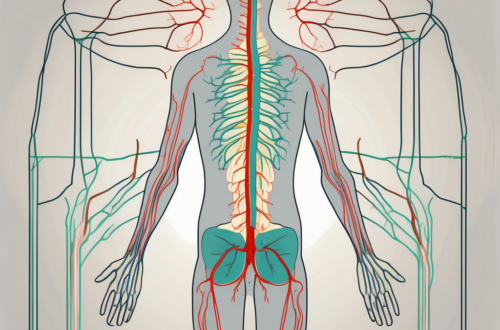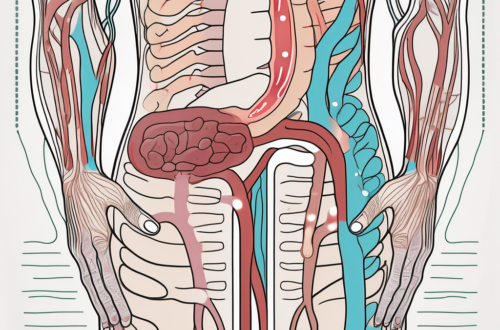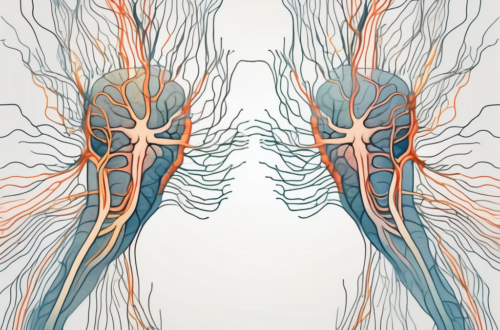The autonomic nervous system is a complex network that plays a crucial role in regulating various bodily functions. It consists of two main divisions: the sympathetic nervous system and the parasympathetic nervous system. Understanding the balance and interplay between these systems is essential for comprehending their role in maintaining overall health and well-being.
Introduction to the Autonomic Nervous System
The autonomic nervous system is responsible for controlling involuntary functions, such as heart rate, breathing, digestion, and more. It operates without conscious effort, ensuring that our bodies continue to function properly even when we are not consciously aware of it. This system coordinates a delicate balance between the sympathetic and parasympathetic divisions, allowing us to adapt and respond to various situations.
Imagine a scenario where you are walking in a park, enjoying the fresh air and the beauty of nature. As you stroll along, your heart beats steadily, your lungs expand and contract rhythmically, and your digestive system processes the food you had for lunch. All of these processes are controlled by the autonomic nervous system, quietly working behind the scenes to keep your body functioning optimally.
The autonomic nervous system is like a conductor, orchestrating a symphony of bodily functions. It ensures that your heart beats at the right pace, pumping oxygen-rich blood to your organs and tissues. It regulates your breathing, allowing you to inhale and exhale effortlessly. It also controls digestion, breaking down the food you eat into nutrients that can be absorbed and utilized by your body.
Defining the Autonomic Nervous System
The autonomic nervous system is composed of a network of nerves that extend throughout the body, closely interacting with organs, glands, and other tissues. Its primary functions include regulating vital processes, maintaining homeostasis, and facilitating appropriate responses to internal and external stimuli.
Let’s delve deeper into the concept of homeostasis. Our bodies strive to maintain a state of balance, where various physiological parameters are kept within a narrow range. The autonomic nervous system plays a crucial role in achieving and maintaining this balance. For example, when your body temperature rises, the autonomic nervous system triggers sweating to cool you down. On the other hand, if your body temperature drops, it initiates shivering to generate heat and warm you up.
Additionally, the autonomic nervous system helps us respond appropriately to different situations. When faced with a threat, the sympathetic division of the autonomic nervous system kicks into action, preparing your body for a fight-or-flight response. It increases your heart rate, dilates your pupils, and redirects blood flow to your muscles, enabling you to react quickly. Conversely, the parasympathetic division promotes relaxation and restoration, slowing down your heart rate, constricting your pupils, and conserving energy.
Components of the Autonomic Nervous System
The autonomic nervous system consists of two main divisions: the sympathetic nervous system and the parasympathetic nervous system. These divisions work together to ensure a balance between the body’s opposing responses, preparing us for action or relaxation as needed.
Think of the sympathetic nervous system as the gas pedal in a car, while the parasympathetic nervous system is the brake pedal. Both are essential for a smooth and controlled ride. The sympathetic division mobilizes your body’s resources during times of stress or danger, while the parasympathetic division helps restore calm and conserve energy when the threat has passed.
It’s fascinating to consider how these two divisions work harmoniously to maintain equilibrium. For example, let’s say you are in a stressful situation, such as giving a presentation to a large audience. Your sympathetic nervous system would activate, causing your heart rate to increase, your palms to sweat, and your muscles to tense. Once the presentation is over, the parasympathetic division takes over, gradually bringing your heart rate back to normal, reducing sweating, and allowing your muscles to relax.
In conclusion, the autonomic nervous system is a remarkable system that silently controls numerous vital functions in our bodies. It ensures that our hearts keep beating, our lungs keep breathing, and our digestive system keeps working, all without us consciously thinking about it. The intricate balance between the sympathetic and parasympathetic divisions allows us to adapt and respond to different situations, maintaining homeostasis and promoting overall well-being.
The Sympathetic Nervous System Explained
The sympathetic nervous system is often referred to as the “fight or flight” response system. It is responsible for mobilizing the body’s resources in times of stress or danger. When activated, it triggers a series of physiological changes, such as increased heart rate, rapid breathing, and heightened awareness, priming the body to respond to perceived threats.
Function and Role of Sympathetic Nerve Fibers
Sympathetic nerve fibers branch out from the spinal cord, reaching various organs and tissues throughout the body. Their primary function is to activate and prepare the body for action, enabling it to cope with physical or emotional stressors. These fibers release chemicals, including adrenaline and noradrenaline, which enhance alertness, increase heart rate, and redirect blood flow to essential organs.
Let’s dive deeper into the function and role of sympathetic nerve fibers. These fibers are part of the autonomic nervous system, which controls involuntary bodily functions. The sympathetic nervous system works in conjunction with the parasympathetic nervous system to maintain balance and regulate bodily processes.
When the sympathetic nerve fibers are activated, they initiate a cascade of responses throughout the body. One of the key effects is the dilation of blood vessels in skeletal muscles, allowing for increased blood flow and oxygen delivery. This enables the muscles to contract more efficiently, enhancing physical performance.
In addition to enhancing physical performance, the sympathetic nervous system also affects various other body functions. For example, it stimulates the release of glucose from the liver, providing a quick source of energy for the body to utilize during times of stress or danger. This glucose release is crucial for sustaining prolonged physical exertion or dealing with acute stressors.
Furthermore, the sympathetic nervous system plays a role in regulating body temperature. When activated, it causes the constriction of blood vessels in the skin, reducing blood flow to the surface and minimizing heat loss. This mechanism helps to maintain core body temperature, ensuring optimal physiological functioning even in challenging environmental conditions.
The Impact of Sympathetic Nerve Fibers on Body Functions
When the sympathetic nervous system kicks into gear, it triggers a range of reactions that enable immediate adaptations for survival. For example, it causes the release of glucose into the bloodstream, enhancing energy availability in response to a perceived threat. It also diverts blood away from the digestive system and towards skeletal muscles, ensuring adequate oxygen supply for physical exertion.
Moreover, the sympathetic nervous system influences the respiratory system. It stimulates the bronchial smooth muscles to relax, resulting in bronchodilation and increased airflow to the lungs. This allows for improved oxygen intake and carbon dioxide removal, facilitating efficient gas exchange during periods of heightened physical activity or stress.
Another significant impact of sympathetic nerve fibers is their influence on the cardiovascular system. Activation of the sympathetic nervous system leads to an increase in heart rate and cardiac output, ensuring a sufficient blood supply to the vital organs and muscles. Additionally, it causes vasoconstriction in non-essential organs, such as the digestive system, redirecting blood flow to areas that require it the most.
Furthermore, the sympathetic nervous system affects the urinary system. It reduces urine production by promoting water reabsorption in the kidneys, conserving fluid for other bodily functions. This mechanism is crucial for maintaining fluid balance and preventing dehydration during periods of stress or physical exertion.
In conclusion, the sympathetic nervous system plays a vital role in preparing the body for action in response to stress or danger. Its activation leads to a wide range of physiological changes that enhance physical performance, increase alertness, and redirect resources to essential organs. Understanding the function and impact of sympathetic nerve fibers provides valuable insights into the body’s adaptive responses and its ability to cope with various challenges.
The Parasympathetic Nervous System Uncovered
The parasympathetic nervous system is often referred to as the “rest and digest” response system. Its primary function is to promote relaxation, conserving and restoring energy reserves. This division works in opposition to the sympathetic nervous system, balancing the body’s responses and facilitating restorative processes.
But what exactly happens when the parasympathetic nervous system is activated? Let’s dive deeper into the function and role of parasympathetic nerve fibers.
Function and Role of Parasympathetic Nerve Fibers
Parasympathetic nerve fibers originate from the brainstem and the lower spinal cord. They are responsible for slowing down bodily processes, promoting digestion, and facilitating relaxation. These fibers release acetylcholine, a neurotransmitter that counteracts the effects of sympathetic activation, resulting in decreased heart rate, relaxed muscles, and enhanced digestion.
Imagine a scenario where you’ve just finished a heavy meal. As your body needs to focus on digesting the food, the parasympathetic nervous system kicks in. It sends signals to your stomach, telling it to produce more digestive enzymes and increase blood flow to aid in the breakdown of nutrients. At the same time, your heart rate slows down, allowing your body to conserve energy and focus on the task at hand – digestion.
The Impact of Parasympathetic Nerve Fibers on Body Functions
When the parasympathetic nervous system dominates, it promotes a state of calm and restoration. It helps regulate heart rate, stimulates digestion, and enhances the elimination of waste products. This division plays an essential role in reducing the stress response, allowing the body to conserve energy and recover from periods of heightened activity or stress.
Think about a time when you were feeling stressed and overwhelmed. Your sympathetic nervous system was in full swing, preparing your body for fight or flight. But once the stressful situation subsides, the parasympathetic nervous system takes over, bringing your body back to a state of equilibrium. It lowers your heart rate, relaxes your muscles, and promotes a sense of calmness.
Moreover, the parasympathetic nervous system also plays a crucial role in promoting restful sleep. As you prepare to sleep, your body needs to wind down and enter a state of relaxation. The parasympathetic nervous system helps facilitate this process by slowing down your heart rate, reducing blood pressure, and promoting a sense of tranquility.
So, the next time you find yourself feeling relaxed and at ease, thank your parasympathetic nervous system for doing its job. It’s the unsung hero that allows your body to rest, digest, and restore.
The Interplay between Sympathetic and Parasympathetic Systems
The sympathetic and parasympathetic systems work in close coordination, constantly adjusting and fine-tuning bodily responses to maintain balance and optimize function. Their intricate interplay allows us to adapt to varying situations and ensure the body’s overall equilibrium.
The sympathetic system, often referred to as the “fight or flight” response, prepares the body for action in times of stress or danger. It increases heart rate, dilates blood vessels, and redirects blood flow to the muscles, enabling us to respond quickly and effectively. On the other hand, the parasympathetic system, known as the “rest and digest” response, promotes relaxation and restoration. It slows down heart rate, constricts blood vessels, and directs blood flow towards the digestive system, allowing for optimal digestion and absorption of nutrients.
Balancing Act: Sympathetic and Parasympathetic Systems
When both systems are in balance, our bodies can efficiently navigate between heightened states of arousal and restful states of recovery. A healthy balance between sympathetic and parasympathetic activity is fundamental to overall well-being.
Imagine a scenario where you are walking through a dense forest and suddenly encounter a bear. Your sympathetic system kicks into high gear, releasing stress hormones like adrenaline, which triggers a rapid increase in heart rate and blood pressure. This physiological response prepares you to either fight the bear or flee from it. Once the danger has passed, the parasympathetic system takes over, helping you calm down and return to a state of relaxation.
It is important to note that the sympathetic and parasympathetic systems do not work independently of each other. They are constantly communicating and adjusting their activity levels to ensure the body functions optimally. For example, during exercise, the sympathetic system increases blood flow to the muscles, while the parasympathetic system decreases blood flow to the digestive system, redirecting resources to where they are needed most.
Effects of Imbalance between Sympathetic and Parasympathetic Systems
Imbalances between the sympathetic and parasympathetic systems can have significant implications for our health. An overactive sympathetic system can lead to chronic stress, cardiovascular problems, digestive issues, and a weakened immune system. Constantly being in a state of heightened arousal can take a toll on our bodies, leading to long-term health problems.
On the other hand, an underactive sympathetic system can result in sluggishness, impaired stress response, and reduced ability to cope with emergencies. Without the ability to activate the fight or flight response when needed, we may find ourselves feeling overwhelmed and unable to effectively handle challenging situations.
It is essential to maintain a healthy balance between the sympathetic and parasympathetic systems through practices such as regular exercise, stress management techniques, and adequate rest and relaxation. By nurturing this delicate interplay, we can optimize our body’s response to different situations and promote overall well-being.
The Role of Nerve Fibers in Health and Disease
Nerve fibers, specifically those within the autonomic nervous system, play a vital role in our well-being. Their proper functioning is critical for maintaining optimal physiological processes and adapting to different circumstances.
Let’s dive deeper into the fascinating world of nerve fibers and explore their impact on our health.
Nerve Fibers and Their Impact on Health
Healthy nerve fibers ensure efficient communication between the brain, organs, and tissues, allowing for proper regulation of bodily functions. They act as messengers, transmitting electrical signals and coordinating responses throughout the body. This intricate network of nerve fibers enables us to perform daily activities, such as walking, talking, and even breathing, effortlessly.
Imagine a well-orchestrated symphony, where each instrument plays its part to create a harmonious melody. Similarly, nerve fibers work in unison, relaying information at lightning speed, ensuring the smooth functioning of our bodily systems.
For example, when you touch a hot stove, nerve fibers in your hand quickly send a signal to your brain, prompting an immediate withdrawal reflex. This rapid response prevents further injury and showcases the incredible speed and efficiency of nerve fibers.
Moreover, nerve fibers play a crucial role in maintaining homeostasis, the delicate balance within our bodies. They regulate heart rate, blood pressure, digestion, and even control our body temperature. Without properly functioning nerve fibers, these vital processes would be disrupted, leading to a cascade of health issues.
How Nerve Fibers Contribute to Disease Development
Unfortunately, dysfunction or damage to nerve fibers can lead to the development of various diseases. One such condition is autonomic neuropathy, which is characterized by damage to autonomic nerve fibers.
Autonomic neuropathy disrupts the balance between the sympathetic and parasympathetic systems, two branches of the autonomic nervous system responsible for controlling different bodily functions. This imbalance can manifest in a variety of symptoms, including orthostatic hypotension (a drop in blood pressure upon standing), digestive problems, and impaired temperature regulation.
Imagine feeling lightheaded and dizzy every time you stand up, or experiencing constant digestive discomfort. These symptoms, caused by damaged nerve fibers, can significantly impact one’s quality of life.
Furthermore, nerve fiber damage can also contribute to the development of conditions such as diabetic neuropathy, where high blood sugar levels result in nerve damage, particularly in the extremities. This can lead to numbness, tingling, and even loss of sensation, making it difficult to perform daily tasks and increasing the risk of injuries.
Understanding the intricate relationship between nerve fibers and disease development is crucial for healthcare professionals. By identifying and addressing nerve fiber damage early on, they can implement appropriate interventions to mitigate symptoms and improve patients’ overall well-being.
In conclusion, nerve fibers within the autonomic nervous system play a vital role in maintaining our health. Their efficient communication and coordination ensure the proper functioning of bodily processes. However, when nerve fibers are damaged or dysfunctional, various health issues can arise. It is essential to prioritize the health of our nerve fibers and seek appropriate medical care when needed.
Conclusion: The Significance of Understanding Nerve Fibers
Gaining a comprehensive understanding of sympathetic and parasympathetic nerve fibers is crucial for comprehending the intricate workings of the autonomic nervous system. Recognizing their roles in maintaining balance, responding to stress, and supporting overall health underscores the importance of prioritizing their well-being.
Recap of Sympathetic and Parasympathetic Nerve Fibers
The sympathetic and parasympathetic nerve fibers are integral components of the autonomic nervous system. They work together to ensure that our bodies can respond appropriately to different situations, promoting either heightened states of alertness or restful states of recovery.
Future Implications of Nerve Fiber Research
Advancements in nerve fiber research hold significant promise for improving our understanding of the autonomic nervous system and its role in health and disease. Further insights into these intricate networks can pave the way for more targeted therapeutic interventions and personalized treatments for various conditions.
It is important to note that while this article provides valuable insights into the role of sympathetic and parasympathetic nerve fibers, it does not replace medical advice. If you have concerns or specific health-related questions, it is always best to consult with a healthcare professional who can provide personalized guidance based on your unique circumstances.





